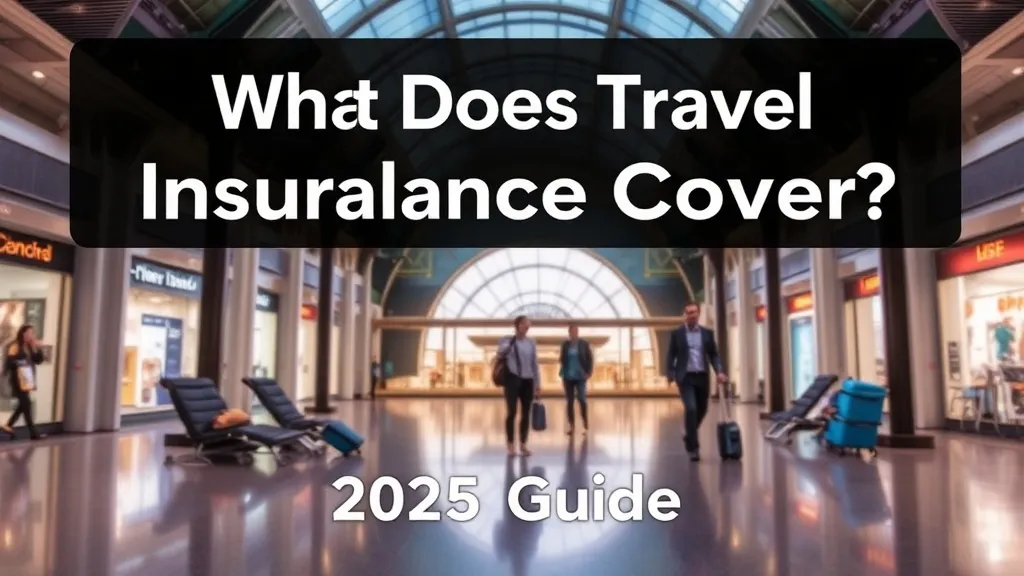What Does Travel Insurance Cover? 2025 Guide
Meta Description: Wondering what travel insurance covers? Our 2025 guide details everything from medical emergencies and cancellations to lost luggage. Get the facts.
You’ve planned the perfect getaway, but have you thought about the what ifs? What does travel insurance cover anyway? You’re not alone—nearly 65% of U.S. travelers purchased a plan in 2024 to guard against unexpected costs (Squaremouth). You’ll learn exactly which scenarios are protected, how much coverage you can expect, and smart strategies for choosing the right plan.
Surprising fact: the average claim in 2024 was $2,475—don’t let that be your expense. Ready? Let’s break it down.
Table of Contents
- Types of Coverage Included in Travel Insurance
- Typical Coverage Limits and Examples
- Exclusions and Common Mistakes to Avoid
- How to Choose the Right Policy in 2025
- Claims Process and Best Practices
- Frequently Asked Questions
- What is covered by travel insurance in 2025?
- Does travel insurance cover COVID-19?
- How much does travel insurance cost?
- Can I buy travel insurance after booking?
- Are adventure sports covered?
- Conclusion
Types of Coverage Included in Travel Insurance
Ever wonder why some people say travel insurance is a trip’s best friend? It’s because it blends several protections into one policy.
Travel mishaps can ruin a dream vacation. In other words, coverage matters. Let me explain why each type is a lifesaver.
- Trip Cancellation & Interruption: Reimburses prepaid, non-refundable costs if your trip is canceled for covered reasons.
- Emergency Medical & Dental: Covers treatment abroad, from a sudden illness to tooth extractions.
- Baggage Loss & Delay: Pays for essentials when luggage goes missing.
- Emergency Evacuation & Repatriation: Transports you to a safe facility or home country if needed.
- Accidental Death & Dismemberment: Provides a lump sum to beneficiaries for severe accidents.
Example: When Sarah’s hotel flooded in October 2024, her trip interruption coverage reimbursed her $1,200 in rebooking fees—talk about relief.
“Travel insurance is peace of mind in a policy,” says Jane Thompson, Senior Analyst at NerdWallet.
Actionable takeaway: List your biggest travel risks first—medical, cancellation, baggage—and ensure your plan covers each one.
Typical Coverage Limits and Examples
Numbers tell the story. Without limits, you’re sailing blind.
Coverage limits define what you’ll actually get back. Let’s peek at standard ranges.
- Trip Cancellation: Up to 100% of prepaid, non-refundable trip costs.
- Emergency Medical: Generally $25,000–$100,000 per person.
- Baggage Loss: Often $750–$1,500 per traveler.
- Trip Delay: Reimbursement for meals, lodging, transport ($100–$200 per day).
Example: Mike filed a $2,000 medical claim after fracturing an ankle in Spain. His plan’s $50,000 limit covered his entire hospital stay.
Data point: The average cost of a 15-day plan in 2025 is $311, up slightly from 2024 (Squaremouth).
What’s next? Check policy brochures carefully. Jot down the dollar amounts and compare side by side.
Exclusions and Common Mistakes to Avoid
Here’s the thing: a low premium might hide big gaps.
Knowing what’s not covered is as important as what is. Don’t get caught off guard.
- Pre-existing medical conditions (unless you add a waiver).
- High-risk activities like scuba diving or base jumping.
- Acts of war or civil unrest in certain countries.
- Routine check-ups or elective procedures.
- Some natural disasters (check specific policy language).
Example: John ignored the adventure sports exclusion and got stuck with a $15,000 bill after a paragliding accident.
“Read the fine print—exclusions live in the smallest font,” warns Dr. Lisa Carter, Professor of Risk Management at USA.gov.
Actionable takeaway: Highlight all exclusions in your policy and ask your agent about anything unclear.
How to Choose the Right Policy in 2025
Feeling overwhelmed? You’re not the only one.
Selecting the best plan boils down to three clear steps.
- Assess Your Needs: Business trip, family vacation, senior travel? Identify your top risks.
- Compare Quotes: Use at least three providers. Look beyond price—check reviews and claim satisfaction scores.
- Read Policy Docs: Focus on coverage limits, exclusions, and the claim process.
Example: Emily chose a modular plan that saved her 20% by dropping excursion coverage she didn’t need.
“Picking travel insurance is like tuning a car—you want the engine you need, not extras you won’t use.” – Mark Reynolds, Travel Risk Consultant
Actionable takeaway: Create a simple spreadsheet to compare premiums, limits, and exclusions side by side.
Claims Process and Best Practices
Filing a claim doesn’t have to be a headache—if you’re prepared.
Know the typical steps so you can breeze through the process.
- Document Everything: Photos, receipts, police reports for theft or accidents.
- Submit Promptly: Most insurers require notices within 24–72 hours for emergencies.
- Follow Up Digitally: Many carriers offer apps to track your claim and chat with adjusters.
Example: Carlos used his insurer’s mobile app to submit a dental claim overseas. Funds were deposited in his account within 48 hours.
“Digital claims reduce turnaround time by up to 40%,” reports the Centers for Disease Control and Prevention.
Actionable takeaway: Keep digital copies of all documents—screenshots work too.
Frequently Asked Questions
What is covered by travel insurance in 2025?
Typically trip cancellation, emergency medical, baggage loss, evacuation, and sometimes even rental car damage.
Does travel insurance cover COVID-19?
Some plans include coronavirus coverage. Always verify policy language or add a pandemic rider if available.
How much does travel insurance cost?
On average $311 for a 15-day trip in 2025, though it varies by age, destination, and coverage levels.
Can I buy travel insurance after booking?
Yes, most providers allow purchase up to departure—but you’ll lose pre-existing condition benefits if you wait too long.
Are adventure sports covered?
Only if you add a specific sports waiver. Always confirm before you strap on that harness.
Conclusion
The bottom line is travel insurance isn’t one-size-fits-all. You’ve seen what travel insurance covers, typical limits, exclusions, and how to pick the right plan in 2025. Armed with these insights, you’ll avoid common traps and protect your wallet.
Next steps:
- List your top travel risks and desired coverage.
- Compare at least three quotes (focus on digital claims ease).
- Read the policy fine print—highlight exclusions and limits.
Armed with a solid plan, you can travel boldly—knowing your trip is backed by the right coverage. Safe travels!





